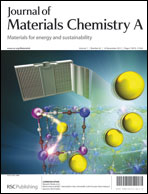Formation of catalytically active gold–polymer microgel hybrids via a controlled in situ reductive process†
Abstract
A newly developed N-vinylcaprolactam/acetoacetoxyethyl methacrylate/acrylic acid based microgel displays in situ reductive reactivity towards HAuCl4, forming hybrid polymer–gold nanostructures at ambient temperature without additional reducing agents. The colloidal gold nanostructure is selectively formed in the core of the microgel and the composite structure is used as a noble metal catalyst, the activity of which can be tuned depending on the size of the formed core. The hybrid particles can easily be isolated after catalysis via centrifugation and re-used with retention of the catalytic activity.


 Please wait while we load your content...
Please wait while we load your content...